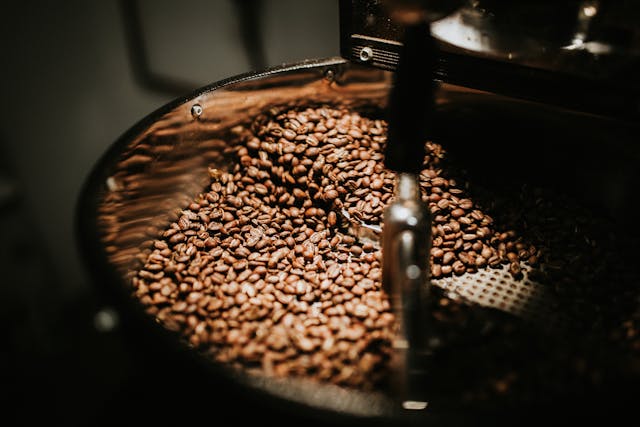
How does roasting coffee beans change their flavor? Roasting the coffee beans changes their flavor because they lose a lot of water and they start to caramelize.
When you buy coffee in a shop, you will most likely be buying roasted beans. You can buy unroasted coffee beans, but you have to seek them out. The coffee in your local supermarket will all be roasted and that is because the drink doesn’t taste like coffee unless the beans have been roasted. You can buy your own roaster and roast them at home, but most people don’t want to do that. You can make coffee with unroasted beans, and some people do, but it doesn’t taste like coffee. It is called green coffee and it is supposed to be good for weight loss. It tastes very grassy, acidic, and bitter. Unroasted coffee beans are potentially better for you and they have more caffeine. They are good for your health because raw coffee beans contain a compound called chlorogenic acid, which has anti-inflammatory and antioxidant properties. It is good for the brain and neurodegenerative diseases because it can reduce inflammation. When you roast the coffee beans, you lose this compound and a lot of the benefits of the coffee bean. So, I guess you have to choose whether you want coffee that tastes grassy and is good for your brain, or coffee that tastes like … coffee.
Coffee beans come from a fruit called a coffee cherry. It depends on the size and the species, but the average coffee tree produces 2,000 coffee cherries a year, which is 4,000 beans, which is about 500g of coffee. That bag of coffee you just bought contains all of the beans produced by one tree over an entire year! That will make me appreciate each cup a lot more. The cherries start to grow, become the size of a grape, and ripen, turning red. The cherries on one tree will ripen at different times so they are picked by hand, if possible. Once the cherries are picked, they are pulped to remove the beans. There are two beans per cherry. The beans are cleaned, sorted by quality, and then roasted. And this is where the magic we are interested in happens.
When the beans are roasted, the color and the taste change dramatically. The first step is to dry the coffee beans because they have too much moisture. This takes about 8 minutes in a drum roaster and raises their temperature to 150 ℃. The second step is to keep heating the beans and to slow down the process. The beans are heated between 150 ℃ and 170℃ for an extended period of time because this is where the Maillard reaction happens. At this temperature, there is a chemical reaction between amino acids and sugars, which creates a compound called melanoidins. Melanoidins are brown and they have the distinctive taste that comes with the Maillard reaction. It is the taste you get on browned toast or seared steak and it is why those things go brown. When the Maillard reaction happens, hundreds of different flavor and aroma compounds are produced. The length that the coffee beans undergo the Maillard reaction is controlled to alter their flavor profile. A longer time will make the coffee thicker and a shorter time will make it sweeter and more acidic. At the end of this stage, the beans have changed color and they burst because they are unable to contain the heat energy inside them.
At the end of the Maillard reaction, the coffee bean undergoes Strecker degradation, which is where some of the amino acids are converted into aldehydes and ketones, amongst other compounds. These give a lot of the aromas and flavors of the coffee. Two examples of those compounds: aldehydes have a fruity, green aroma, and guaiacol has smoky, spicy scents. The chlorogenic acid that is in green coffee beans is also broken down into different compounds that alter the flavor. If you keep roasting the coffee bean and the heat goes above 170 ℃, the sugars in the bean will start to caramelize. The heat breaks down complex carbohydrates into smaller sugar molecules, which give it a sweeter taste. This is why caramelized onions taste sweet. However, you have to be careful because if you caramelize the sugars too much, they will become very bitter.
Coffee beans themselves have different properties, tastes, and aromas, but the way they are roasted can vastly alter their flavor and scent. Changing the temperature, or the length of time at any stage in the roasting process, can have a big effect on the overall coffee. This is why coffee bean roasting is such an important job. And this is what I learned today.
Read these:
Sources
https://yorkemporium.co.uk/blogs/explore/how-the-roasting-process-influences-coffee-flavour
https://drinksupercoffee.com/blog/nutrition/green-coffee
https://www.treatt.com/news/the-journey-of-the-coffee-bean
https://wanderinggoat.com/pages/growing-coffee
https://perfectdailygrind.com/2019/03/what-happens-during-coffee-roasting-the-chemical-changes
https://en.wikipedia.org/wiki/Maillard_reaction
Photo by Juan Pablo Serrano : https://www.pexels.com/photo/shallow-focus-photo-of-coffee-beans-894695/
